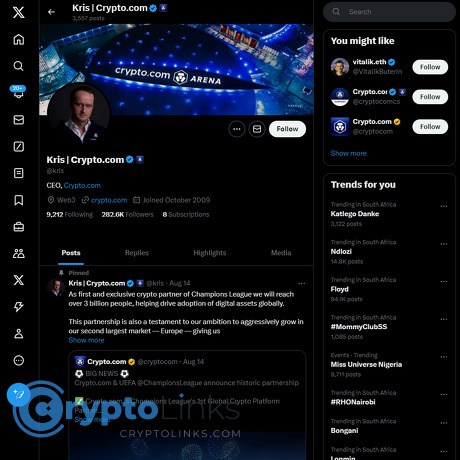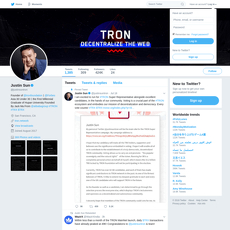Kris | Crypto.com Review
Kris | Crypto.com
x.com
Kris | Crypto.com Review Guide: Everything You Need to Know + FAQ
Got questions about Kris Marszalek, Crypto.com’s current status, or how to unlock CRO without breaking something? Wondering whether the 24‑hour withdrawal wait is worth keeping on, or if those US “shutdown” headlines were the real deal? You’re in the right spot.
I’ll keep this simple: you’ll get straight answers, quick how‑tos, and the key signals I watch on Kris’s X profile so you can make smarter decisions without wading through rumor threads.
The real headaches most people hit
Here are the pain points I see over and over (and yes, I’ve hit some of them myself):
- Mixed signals from X vs. reality: A post or quote-tweet from Kris flies around, but it’s not obvious what actually changed in‑app.
- US access confusion: Headlines about “Crypto.com shutting down in the US” still circulate, even though they often reference a specific institutional service from 2023—not everyday retail users.
- Withdrawal friction at the worst moment: You add a new address, and suddenly there’s a 24‑hour hold. When you need to move fast, it feels like a roadblock.
- CRO lockups and plan changes: The 365‑day clock finishes… then what? Some folks expect an auto‑unlock. Others don’t know where the new “subscribe” step lives.
“Why can’t I withdraw right now?”
Because adding a new address triggers a security buffer. Think of it like a seatbelt—annoying until the crash you didn’t plan for.
There’s a reason these protections exist. Law‑enforcement and industry reports have consistently highlighted social‑engineering as a top cause of crypto losses. The FBI’s IC3 reports have tracked billions in investment‑fraud losses tied to cryptocurrency; small frictions like withdrawal holds and whitelisting can stop an account‑takeover from turning into a total drain. That doesn’t make the wait fun—it just makes it smart.
What you’ll get from this guide
I’ll show you exactly how to read Kris’s updates, what’s actually live on Crypto.com right now (including for US users), how to handle the 24‑hour withdrawal lock without shooting yourself in the foot, and how CRO unlocking works after the 365‑day period. I’ll keep it practical and skip the fluff.
Here’s what I’ll cover (in plain English)
- Who Kris is and why his posts matter: Quick profile and how to read his X updates without getting misled by replies and quote‑tweets.
- What’s live on Crypto.com today: App, Exchange, Visa Card, DeFi Wallet, and how US availability actually works.
- Security controls that help, not hinder: When to keep the 24‑hour lock on, how to use 2FA correctly, and why whitelists save headaches.
- CRO lockups and Level Up basics: The exact sequence for unlocking after 365 days, and planning your tier moves so you don’t miss perks.
- Fast FAQs: Quick answers to the questions I get every week—US access, withdrawal waits, who Kris is, and what to check before moving funds.
If you’ve ever wondered whether Kris’s reassurance posts actually matched what happened next—or which signals on his timeline I trust—keep reading. Next up, I’m going to answer a simple question: who is Kris Marszalek, and what should you pay attention to on his X feed?
Meet Kris Marszalek: the person behind Crypto.com
Kris Marszalek is a Polish entrepreneur based in Singapore, best known as the co‑founder and CEO of Crypto.com. Before the brand you know today, there was Monaco—a card-and-payments project that pivoted into a full crypto platform and later rebranded after acquiring the coveted crypto.com domain. His decisions show up in the products you tap daily, the cards in your wallet, and the compliance milestones that keep the platform running in tough jurisdictions.
I watch leaders through two lenses: what they say and what ships. With Kris, the signal is in how quickly public statements line up with official actions—product updates, proof-of-reserves refreshes, and regulatory approvals. When those match, user confidence follows.
Brief background and track record
Monaco’s early play was simple: bridge crypto and payments. The rebrand to Crypto.com marked a shift to a broader, more regulated, and partnership-heavy strategy. A few patterns have stayed consistent, and they matter for your day‑to‑day:
- Brand-first, utility-second—but both matter: high-visibility partnerships (UFC, Formula 1, and the naming rights to what’s now the Crypto.com Arena) paired with incremental app and exchange improvements.
- Consolidation when it reduces friction: the MCO-to-CRO token migration (2020) was messy for some, but it simplified the token economy and product tiers around a single asset.
- Compliance as a moat: staged wins across key regions and ongoing proof‑of‑reserves updates at crypto.com/trust—boring, yes, but essential when markets wobble.
- “Talk + receipts” leadership: announcements often come with screenshots of licenses, links to status pages, and follow‑ups in the app or blog. That cadence builds accountability.
There’s a reason this style works. Industry research shows that consistent executive communication during uncertainty correlates with lower user churn and quicker recovery of trust. Public trust reports (like the annual Edelman studies) echo the same finding: frequent, specific updates beat promotional noise when things get tense.
Why his X (Twitter) feed matters
Kris uses @Kris as a real‑time channel during stress, launches, and policy shifts. It’s not a meme stream; it’s where you’ll see early hints of what’s about to change in your app. Expect a handful of posts per week in normal periods and short bursts during events. He tends to add links, screenshots, or dates—that’s what I look for.
“Trust is built in drops and lost in buckets.”
Here’s how I separate signal from chatter when scrolling his feed:
- Signal: timestamps, hard numbers, links to official domains (blog, help center, status page), or third‑party validators (auditors, regulators, analytics partners). If there’s a date, a metric, or a document, I pay attention.
- Chatter: retweets without new info, victory laps, or broad market talk. Nice for sentiment, not for decisions.
- Follow‑through check: did the post get an official mirror on the site or in‑app within 24–72 hours? If yes, I upgrade it from “announcement” to “actionable.”
- Ratio watch: if replies are heavy with the same complaint (withdrawals, card issues, region access) and he responds quickly with specifics, that’s a positive signal on ops responsiveness.
One more tip: context matters. When he posts during a volatile window, compare the message to the status page and proof‑of‑reserves. If all three align, I treat it as high‑confidence.
Key moments to remember
- 2018 — Monaco → Crypto.com: the rebrand reset the narrative from a single card product to a full ecosystem. It was the start of the “platform + brand” playbook.
- 2020 — Token consolidation: the MCO to CRO migration unified staking, cards, and rewards. Not painless for everyone, but it set the foundation for later product tiers.
- 2021 — Partnerships go mainstream: UFC, Formula 1, and the Los Angeles arena naming deal pushed Crypto.com into the non‑crypto spotlight, accelerating user acquisition globally.
- Nov 2022 — Peak fear communications: amid industry-wide panic, Kris posted that operations were normal, addressed the misrouted ETH incident publicly, and leaned on proof‑of‑reserves. The message‑to‑action loop—tweets, then public dashboards—was a key trust test.
- 2023 — Market reset and regional clarity: posts clarified where the business was focusing, including segmentation of products by region and user type, plus ongoing licensing updates that showed a bias toward regulated growth.
- 2024 — Transparency cadence: continued proof‑of‑reserves refreshes and licensing milestones (including progress in the UAE and Europe) underscored the “compliance-first” stance.
If you want a practical way to build your own trust score, do this: create a simple note with three columns—what he said, when he said it, what happened next. Check back after 7, 30, and 90 days. Over time, you’ll see a pattern of how quickly words turn into product updates or policy changes. That pattern, not a single tweet, is what matters.
So, if that’s the person shaping the tone and tempo, what’s actually live on the platform right now—and what changed this year? Ready for a clean snapshot that skips the marketing fluff and tells you what you can use today?
Crypto.com in 2025: what’s live, what changed, and what to expect
I keep a running checklist of what’s actually usable on Crypto.com right now, because screenshots and old Reddit threads can be wildly out of date. Here’s the clean snapshot I use before I buy, trade, stake, or move money.
“Trust what you can check — app status, fee tables, and your own test transactions.”
Products at a glance
Think of Crypto.com as three lanes on the same highway. Pick the one that matches how you actually use crypto:
- App (Retail hub): Buy/sell, fiat on-ramps/off-ramps, manage your Visa Card, Earn, and quick swaps. Best for everyday users who want a single place to top up a card, DCA into majors, and cash out to a bank.
- Exchange (pro trading): Web and pro interface for order books, spot, and (region-permitting) margin/derivatives. Best for traders who care about maker/taker fees, depth, and APIs. Availability varies by country; US access is the tricky part (more below).
- DeFi Wallet (self-custody): You hold the keys. Supports multiple networks and native staking for certain chains. Best for self-custody fans who want on-chain control and the option to connect to dapps. Not the same as the App wallet.
- Visa Cards: Prepaid Visa with CRO-based tiers for perks and cashback. Useful for people who actually spend crypto-linked funds and want tangible rewards; less useful if you never swipe.
- Earn/staking: Time-bound or flexible yields that change by asset, term, and region. Handy for parked assets—but always confirm availability and rates in your jurisdiction before moving size.
Real example: if I’m buying USDC with fiat and plan to spend it this month, I’ll use the App and keep it liquid. If I’m placing limit orders on volatile alts with alerts and API hooks, I’m on the Exchange. If I’m parking ETH for the long haul or playing with Cronos or Arbitrum, I push to the DeFi Wallet so I control the keys.
Is Crypto.com shutting down in the US?
No. What tripped people up was a very specific 2023 change:
- On June 9, 2023 Crypto.com said it would shut down its US institutional exchange by June 21 due to low demand from big institutions.
- This was not the retail App or the Visa Card. US retail users continued with the App (subject to normal state-by-state rules).
In 2025 the nuance remains: the App is the default path for US retail. The Exchange’s feature set and access for US users are limited compared to many other regions, and derivatives are typically restricted. Always check what’s available to your specific state in-app before you plan a workflow that assumes Exchange features.
Pro tip: if your plan relies on an Exchange-only feature (API trading, specific pairs), confirm access with a tiny test order. If you can’t see the market or get API keys, don’t architect around it.
Fees, limits, and supported assets
Most “surprise” costs happen in three places: the order book, the card top-up rails, and the network you pick for transfers. Here’s how I avoid gotchas.
- Maker/taker on the Exchange:
- Fees change by 30-day volume, VIP tier, and CRO stake. Maker is usually cheaper than taker.
- Action: Place more limit orders than market orders if you can wait. Check the current fee tier in your account page before large trades.
- App spreads and quick swaps:
- Convenience comes with embedded spread. For larger amounts, compare the App’s instant price to posting a limit on the Exchange (if available to you).
- Action: For anything meaningful, do a small “price check” trade first and look at the effective rate you’re getting.
- Card top-ups and cash advances:
- Debit card top-ups are usually cleaner. Some credit card issuers treat crypto purchases or top-ups as “cash advances,” which can trigger fees and higher APR.
- FX conversions can be pricier on weekends across many fintech cards, not just crypto cards; several providers publish a weekend markup in their fee tables.
- Action: Use debit/bank transfer where possible, avoid weekend FX for big conversions, and read your card issuer’s cash advance policy.
- Earn rates and regional limits:
- Rates move, some assets go in and out, and availability can differ by country (and in the US, often by state).
- Action: Check the live Earn list in-app right before you commit. If the APY isn’t visible to you, assume it’s not available in your region.
- Supported assets and networks:
- The same token symbol can live on multiple networks. Crypto.com supports specific networks per asset; sending on the wrong one risks loss.
- Stablecoins aren’t equal on fees: industry data (including work from Chainalysis) has shown low-fee networks capture massive stablecoin flow because users chase cheaper finality.
- Action: Match the exact deposit network shown in-app. For transfers, prefer a faster/cheaper network both sides support (for example, sending USDC on a low-cost L2 rather than expensive L1 if both wallets support it).
- Withdrawal fees and speed:
- Network fees are dynamic. Congestion spikes cost and time. Some assets allow “internal transfer” to other Crypto.com users instantly and cheaply.
- Action: If speed matters, pick assets and networks that settle quickly. Send a tiny test first and scale up.
Two quick examples from my notes:
- I once moved USDT using the default ERC‑20 route and paid noticeably higher gas than a comparable transfer on a cheaper supported network. Same token, different network, very different costs.
- Weekend international card spend cost me more than a weekday run. Since then, I avoid large FX conversions on Saturdays and Sundays and stick to debit rails for top-ups.
If you want a single sanity pass before any big move, here’s mine:
- Confirm product lane: App for fiat/card, Exchange for order books (if available), DeFi Wallet for self-custody.
- Check region toggles: US users, verify what the App vs. Exchange shows for your state.
- Pick the network that both sender and receiver support; screenshot the network selection.
- Send a small test and compare timestamps/fees to your expectations.
One last thing—security settings can save you from yourself when you’re moving real money. Want to make transfers safer without adding friction, and understand that 24‑hour withdrawal lock everyone debates? I’ll show you exactly what I enable next and why it matters.
Security settings that actually help: withdrawal lock, 2FA, whitelists
I keep security boring on purpose. It’s the stuff you set once, forget, and then thank yourself for when markets go wild. Here’s the exact setup I use to make moving funds fast when it matters, without leaving easy doors open for attackers.
“Trust, but verify.” — the only reasonable way to move money online.
24‑hour withdrawal lock: how it works and how to disable it
This feature adds a 24‑hour hold after you change your withdrawal address book. It’s meant to stop rushed drain attempts if someone compromises your account and tries to add a fresh address.
When do I keep it on? Almost always. When do I turn it off? Rarely—only if I must move a large amount quickly and I’m on a connection/device I trust.
If you must disable it:
- Open Menu > Settings
- Tap Security > 24‑hour Withdrawal Lock
- Toggle off
- Confirm Disable
- Authenticate with passcode or biometrics
Pro tip: If you do turn it off for a planned transfer, set a reminder to re‑enable it right after the funds settle. I also whitelist the destination first (more on that below), wait out the 24 hours if possible, then keep the lock on permanently.
2FA, address whitelisting, and anti‑phishing
This trio closes most of the real‑world gaps I see when people get phished or rushed.
- Use an authenticator app, not SMS. Apps like Authy or Google Authenticator are tougher to intercept than text messages. Microsoft has reported that enabling any form of MFA stops the overwhelming majority of automated account takeover attempts. If your setup supports hardware keys (FIDO2), that’s even better for high‑value accounts.
- Turn on withdrawal address whitelisting. Lock withdrawals to pre‑approved addresses only. Even if someone gets in, they can’t add a new address without triggering controls like the 24‑hour lock and 2FA. I keep a small list of “known good” destinations: my self‑custody wallet, a secondary wallet, and one reputable exchange account.
- Set an anti‑phishing code for emails. This is a short phrase only you know. Every official email from the platform should include it. If it’s missing, I treat the email as hostile—no clicks, no replies. It’s a simple visual check that cuts through most fake “security alerts.”
Why this matters: Industry data has been clear for years that the human element is behind most breaches. Reports like Verizon’s annual DBIR repeatedly highlight credentials and social engineering as the main entry points. Your best defense is layering MFA + allow‑lists + simple verification habits.
My safety checklist for moving funds
I use the same routine whether it’s $200 or $200k. It’s fast, and it saves me from dumb mistakes when the market is moving.
- Send a small test first. Especially when moving to a new address or network. I only send the full amount after I see the test land where I expect it.
- Match asset and network perfectly. USDT on ERC‑20 is not the same as USDT on TRON or Cronos. Pick the same network on both the sending and receiving sides. If fees matter, a lower‑cost chain can be smarter—but only if the destination supports it.
- Check if a memo/tag is required. Coins like XRP, XLM, ATOM, and some exchange deposits need a memo/tag. Missing it can park your funds in limbo. I copy both address + memo and paste them into a note to sanity‑check before sending.
- Whitelist first, then wait. I add new addresses to my whitelist ahead of time so I’m not forced to disable protections under pressure. If the 24‑hour lock applies, I plan around it.
- Confirm the destination is live and able to receive. On exchanges, make sure deposits for that coin/network are enabled. On self‑custody, confirm the wallet supports that chain and you have gas for the first move out.
- Use clean devices and connections. No public Wi‑Fi. If I’m traveling, I avoid changing security settings and I prefer a wired connection or my own hotspot.
- Bookmark official domains and the status page. I never click “urgent” links from email or DMs. I load the app or type the URL from my bookmarks. If something feels off, I check the official status page or help center directly.
- Keep proof. I take a quick screenshot of the confirmation screen and save the TxID. If support is needed, having timestamps and IDs speeds things up.
- Lock it back down. After the transfer settles, I verify 2FA is on, the 24‑hour lock is enabled again, and notifications are working.
Real example: I once watched a friend send USDT to a whitelisted address but on the wrong chain—TRON instead of ERC‑20—because the receiving wallet didn’t support it. The test transaction would have caught it. Two minutes saved could have avoided a multi‑day support ticket.
Bonus habit: I keep my “settlement destinations” steady. The fewer addresses and chains I juggle, the fewer mistakes I make under stress.
Quick references if you need them:
- Microsoft Security: why MFA beats passwords alone
- Verizon Data Breach Investigations Report
- Official Help Center for security, whitelists, and email anti‑phishing code setup
You’re set up to move safely. Now, what about the funds you’ve got locked up—specifically CRO? Ready to switch tiers or unlock after 365 days without losing perks at the wrong moment? Let’s sort that out next.
CRO, lockups, and Level Up: what to know before you switch plans
If you’ve ever stared at your CRO stake and wondered, “Should I unlock now, upgrade, or hold tight?” you’re not alone. Card perks, earn tiers, and the whole Level Up flow are tied to timers most people forget about—until the day they try to change something. Let’s make it painless, with real examples and clear guardrails.
“Plan the unlock before the market plans it for you.”
How to unlock CRO after the 365‑day period
Once your 365‑day lockup ends, the app gives you a straightforward path to take back control. Here’s what that looks like in practice:
- Open the Crypto.com App
- Go to Accounts > Crypto Wallet > CRO
- Tap the Lockup / Card Stake tile (naming can vary slightly by app version)
- If your 365 days are complete, you’ll see an Unlock (or Unstake) option. Tap it and confirm the prompts
- Your CRO moves from Locked to Available. You can hold, convert, or withdraw
- If you want to keep your card perks after unlocking, immediately subscribe to your current plan (re‑stake) or choose a different tier and stake for that plan
If the 365‑day timer isn’t done, you won’t be able to unlock yet—you’ll see the remaining days. No shortcut around that timer. If you’re planning a tier change, set a reminder a week before your end date so you can line up your next move.
Important effects the moment you unlock:
- Card cashback/perks tied to the stake pause right away
- The card still works for spending, but you may lose boosted rewards or specific rebates depending on your tier and region
- Re‑staking starts a fresh 365‑day clock from that day
Example: Maria’s unlock
Maria staked for a mid‑tier on January 10, 2024. On January 10, 2025, she taps Unlock and her perks pause instantly. She then re‑stakes the same day—perks resume, but a new 365‑day timer starts on January 10, 2025. If she instead drops to a lower tier, she stakes the lower amount and accepts the new (smaller) perk set with a fresh timer.
Can you “level up” before 365 days? Yes. If you add more CRO mid‑term to reach a higher tier, your perks jump right away—but your 365‑day timer resets from that upgrade date. That reset is the rule that catches people off guard.
Example: Sam’s upgrade
Sam has 90 days left on a lower tier. He adds CRO to reach the next tier in October. New perks start instantly, but his clock restarts and now runs 365 days from October. No partial credit on the old timer.
One more practical note: stake thresholds are set in CRO amounts, not in fiat. If CRO’s price moves a lot during your lock, the fiat value of your stake can swing. That’s great in a bull run, but it cuts both ways—factor it into your timing.
Card tiers, perks, and what changed over time
Perks have evolved. Cashback rates, rebates, and caps have shifted across regions and market cycles, and some benefits were reduced or capped in previous updates. Always check the current terms in‑app before you act—what you remember from last year may not match today’s lineup.
Here’s the grounded way to think about it:
- Value what you actually use: If you don’t use streaming rebates, don’t pay for them via a bigger stake
- Regional rules matter: Perk availability and caps differ by country and even state; confirm in the app before switching tiers
- Keep-or-cut decisions: Some users unlock and keep a smaller stake for a lower tier so they still earn modest cashback while freeing most of their CRO. Others either go all‑in on a higher tier they truly use or go card‑only with no stake
- Metal card stays, perks don’t: If you fully unlock, you’ll still have a working card, but enhanced rewards tied to staking stop until you re‑stake
Why does it feel hard to downgrade even when the math says you should? Behavioral research like Kahneman and Tversky’s work on loss aversion shows we feel the pain of losing perks more than the benefit of saving CRO. Keep that in mind when you run your numbers—don’t let yesterday’s benefit anchor today’s decision.
If you want the latest small print on specific perks, check the official help center or the card T&Cs in‑app. Policies do change.
Timing strategies (without the jargon)
Here’s how I plan tier rotations and unlocks with minimal stress:
- Sync with your spending calendar: If your big annual bills land in March, avoid unlocking in February. Keep perks active through the month you’ll get the most reward
- Decide upgrade vs. wait: If you’re upgrading mid‑term, be okay with the timer reset. If not, set a calendar alert for your exact 365‑day date and upgrade then
- Watch CRO’s price trend: If you’re eyeing a higher tier and CRO is running hot, topping up sooner can cost fewer fiat dollars (but adds price risk). If it’s weak, you may prefer to wait, accepting that perks arrive later
- Keep receipts: Screenshot your plan status before and after you unlock/upgrade. If support needs proof of timing for perk disputes, you’re ready
- Tax sanity: Unlocking itself typically isn’t taxable in many places, but converting or selling CRO can be. Rules vary—log the dates and amounts, and check local guidance
- Don’t move every lever at once: Avoid changing tier, converting CRO, and moving funds off‑platform in the same hour. Spread actions over a day or two so you can verify each step
Quick scenario walkthrough
- Drop a tier at unlock: Unlock on day 365, perks pause. Immediately stake for the lower tier. New perks start, and your new 365‑day timer begins
- Upgrade mid‑cycle: Add CRO now, get higher perks right away, accept the timer reset. Only do this if the extra perks will pay for themselves during the next 12 months of your real spending
- Exit staking: Unlock, keep the card for convenience, but move freed CRO to where it fits your risk plan. Re‑stake only if the perks clearly beat your next best use of funds
If you like having a playbook that adapts to policy changes, the trick is spotting them early. Want to know which signals on Kris’s X feed usually hint that card or tier adjustments are on the way—and how I filter hype from real action? That’s exactly what I’m breaking down next.
Reading Kris on X without the noise: the signals I track
I treat Kris’s X feed like a dashboard. Not every post is a “buy/sell” moment—most are breadcrumbs. The trick is sorting real signals from hype and knowing what to verify right away. Here’s the exact lens I use, with real examples and a repeatable checklist you can run in under a minute.
Product, compliance, and regional signals
When Kris posts, I bucket it into three buckets—then I validate with sources that don’t care about narratives.
- Product rollouts (App/Exchange, cards, earn changes)
- What I look for: version numbers, screenshots, links to the blog or help center, or a status page note for new endpoints/features.
- Why it matters: product changes usually hit documentation and the status page before/around the same time. If there’s no doc link or status entry within 24–72 hours, I treat it as a teaser, not a live change.
- Compliance and licenses (regulatory approvals, registrations)
- What I look for: mention of specific regulators (FCA, MAS, AMF, VARA, etc.) and exact license types. Then I cross-check the regulator’s public register.
- Why it matters: third-party databases (like CCData’s exchange benchmarking) weigh compliance/transparency heavily, so these posts tend to precede real market access upgrades.
- Regional access updates (US notes, card market expansions)
- What I look for: country/state names, any geofencing language, and whether the update is for retail vs. institutional users.
- Why it matters: this is where rumors explode. I always confirm inside the app and in official docs before reacting.
Quick rule of thumb: if a post mentions product or policy changes and doesn’t link to docs, I assume it’s context—not a live switch—until I see it reflected in the help center, official blog, or status page.
What past stress tests taught us
Patterns matter more than individual tweets. Two examples shaped how I read Kris today:
- Contagion fear week in 2022
- He posted operational assurances and the team followed with wallet transparency and a proof snapshot shortly after. Key tells: withdrawals remained live per the status page, and follow-up posts pointed to verifiable disclosures. Price chatter was loud, but operational signals stayed consistent.
- 2023 US institutional shutdown
- Announcements on X matched the blog timeline: institutional exchange only, retail app/card unaffected. Key tells: language was precise, FAQs were updated, and regional availability checks in-app didn’t change for retail users.
Why do I care about cadence? Because transparency has a rhythm. During sensitive changes, I expect:
- Same-day acknowledgment on X with either a link or a time window for docs.
- 24–72 hours for support articles, blog posts, or regulator links to appear.
- Ongoing nudge posts that summarize what changed and where to read the full details.
Operating principle: tweets are hints, status/docs are commitments.
When that rhythm breaks, I adjust my risk view:
- Green flags: posts link to docs/regulators; status page confirms; help center updates land fast.
- Yellow flags: “soon” language without dates; re-announcing prior items; no doc links after a few days.
- Red flags: prolonged silence paired with status incidents or inconsistent replies; major claims without any trace on official pages.
If you like a data-backed approach, I also track independent heuristics. Research and vendor benchmarks consistently rate compliance and transparency as key risk reducers for exchanges, which is why I weight those posts higher than marketing. For example, CCData’s Exchange Benchmark methodology emphasizes regulation, security, and transparency—exactly the stuff you can verify from official links rather than vibes.
- CCData Exchange Benchmark (methodology shows what matters to rating agencies)
- CER.live (security posture, bug bounties, and public transparency trackers)
Resources I actually use
Here’s my short list for fast verification when Kris posts:
- Kris on X (real-time signal, but I always verify)
- Crypto.com Status (incidents, maintenance, API health)
- Crypto.com Help Center (policy changes, country/state availability, feature details)
- Official Blog (product launches, licensing announcements, partnerships)
- Regulator registers (for posts claiming new approvals)
- FCA Register (UK)
- MAS Financial Institutions Directory (Singapore)
- AMF/ACPR Registers (France)
- VARA (Dubai)
My 60‑second “tweet-to-truth” checklist:
- Tag the post: product, compliance, or regional.
- Open the matching source: status page (ops), help center/blog (product/policy), regulator site (license).
- Scan replies from official accounts for clarifications or links.
- Check if the change appears in‑app for your region/account type.
- If nothing corroborates it within 24–72 hours, treat it as forward-looking—not live.
Want the fastest yes/no answers on US access, CRO unlocks, and that 24‑hour withdrawal wait without scrolling X threads? I’ve got the straight shots next—what’s the first question you want cleared up?
FAQs and quick answers
Is Crypto.com shutting down in the US?
No. The June 2023 closure applied to the US institutional exchange only (low demand from big players). Retail users keep access to the App and Visa Card, with normal state-by-state rules. Always confirm availability in-app or on the official site before you plan a move.
More quick answers (CRO unlocks, 24-hour wait, who is Kris?)
- How to unlock CRO lockup: Once your 365-day timer finishes, open your CRO Wallet in the app and subscribe to your current plan to unlock. If the clock isn’t done, you’ll need to wait—no workaround.
- How to bypass the 24-hour withdrawal wait: Settings → Security → 24-hour Withdrawal Lock → toggle off → confirm with passcode/biometrics. I strongly suggest turning it back on after you’re finished moving funds.
- Who is Kris Marszalek? CEO of Crypto.com, Polish entrepreneur based in Singapore. For real-time updates, check his X account: x.com/Kris.
Can I use the Crypto.com Exchange in the US?
Retail Exchange access in the US has had limits and licensing nuances. The App and Visa Card are the default for most US users. If you see a “region not supported” message on the Exchange, that’s normal—use the App or check back for any policy updates.
Why is my crypto withdrawal pending?
- Security triggers: new device, IP/location change, recent password or 2FA change, or a new address added.
- Compliance checks: large or unusual transfers can trigger extra screening (standard across exchanges).
- Network conditions: chain congestion or low fee settings slow confirmations.
Tip: If you changed security settings, expect the 24-hour window. If it’s purely network-related, paste your tx hash into a block explorer and watch confirmations. For status or maintenance, check status.crypto.com.
Is Crypto.com “safe” for holding funds?
I treat any centralized exchange as a trading/fiat on-ramp and keep long-term holdings in self-custody. That’s not a Crypto.com knock—it’s risk management. Crypto.com publishes security and reserve information on their official pages, but remember: crypto balances aren’t FDIC-insured. For peace of mind, move long-term stacks to a hardware wallet.
Security note: NIST’s digital identity guidance has long flagged SMS 2FA as weaker due to SIM-swap risk. Use an authenticator app. Source: NIST 800‑63.
What’s the difference between CRO lockup and Earn?
- CRO lockup (card stake): You lock CRO for card tier perks and potential fee benefits. There’s a 365-day commitment on first stake; after that, you can unlock or restake based on your plan.
- Earn: Time-bound deposits that pay a rate, separate from card staking. Terms, assets, and rates change—always check the latest in-app before committing.
I sent to the wrong network. Can I get funds back?
Usually not. Example: sending USDT to a TRC20 address while selecting ERC20 (or vice versa) can result in permanent loss. Always match asset + network + address format before pressing send. Test with a tiny amount first.
How do I whitelist addresses and reduce transfer risk?
- Use an authenticator app for 2FA (not SMS).
- Enable withdrawal address whitelisting and approve only the wallets you control.
- Keep the 24‑hour lock on by default; turn it off briefly only when needed.
These steps dramatically lower the chance a rushed attacker can drain your funds. SIM swaps are a real issue; carriers aren’t ironclad. The FCC and FTC have both issued warnings on SIM swap scams—treat SMS as a backup, not your primary defense.
How fast are cashouts to my bank?
US ACH typically takes 1–3 business days, sometimes longer on weekends/holidays. Wire transfers are faster but can incur fees. Banks can hold incoming funds if they flag unusual activity. Plan big moves around weekdays.
Card cashback feels delayed—normal?
Most card rewards post quickly after the transaction clears. Some merchants settle late or reverse/adjust amounts, which can delay rewards. If something looks off after a few days, open an in-app chat with the receipt and the last four digits of the card—support can check the settlement.
What if support is slow?
In-app chat is the standard route. During peak volatility, queues grow. Have screenshots ready: order ID, tx hash, timestamps, device model, and OS version. Clear, complete tickets get solved faster.
Where do I check official updates without the noise?
- Kris on X for exec-level signals.
- status.crypto.com for outages/maintenance.
- help.crypto.com for product rules and regional availability.
- crypto.com/tax for the free tax tool (where supported).
Final take
Watch what changes in the app and docs, not just the headlines. Set your security stack right (authenticator app, whitelists, 24‑hour lock), know your CRO timers before you switch tiers, and always confirm US access based on your state. I’ll keep tracking the real updates so you can focus on making clean, confident moves.
CryptoLinks.com does not endorse, promote, or associate with Twitter accounts that offer or imply unrealistic returns through potentially unethical practices. Our mission remains to guide the community toward safe, informed, and ethical participation in the cryptocurrency space. We urge our readers and the wider crypto community to remain vigilant, to conduct thorough research, and to always consider the broader implications of their investment choices.













